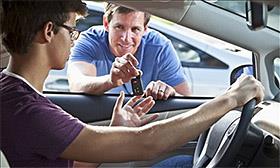 State driving laws aimed at teenagers may need to be extended to all first-time drivers regardless of age, according to a new report from the AAA Foundation for Traffic Safety.
State driving laws aimed at teenagers may need to be extended to all first-time drivers regardless of age, according to a new report from the AAA Foundation for Traffic Safety. As more teens graduate from high school without driver's licenses, they're also passing over state laws designed to protect young drivers from their own inexperience. The result, says AAA, is a pool of riskier first-time drivers -- both young and old -- who are exempt from Graduated Driver Licensing, a system of curfews, passenger restrictions and hourly supervision for those under age 18.
All 50 states have enacted GDL laws to varying degrees, although some states are far more strict than others. In many cases, teens under 18 can't drive without family members in the car until they reach a certain age. Some states even ban teens from using any handheld and mobile devices while in the car.
According to the AAA study, which surveyed more than 1,000 young adults aged 18 to 20 across the country and weighted the results to reflect national demographics, only 44 percent got a driver's license within 12 months of their state's minimum age. Just 54 percent received a driver's license before turning 18; Two decades earlier, AAA found that more than two-thirds of teens 18 and under had a driver's license.
- Driving tips to keep your teen alive
- The staggering cost of teen driving
- Driving a car costs more than $9,000 per year, says AAA
"With one in three teens waiting to get their license until they turn 18, there's a segment of this generation missing opportunities to learn under the safeguards that GDL provides," Peter Kissinger, the AAA Foundation president and CEO, said in a statement. “For most, it's about not having a car or having alternatives for getting around that are the top reasons cited for delaying what has traditionally been considered to be a rite of passage."
Indeed, unemployment and high gas prices are likely factors. At the start of the recession in 2008, the Governors Highway Safety Association found the first significant decline in teen driver deaths.
In March, the GHSA, a nonprofit that represents highway offices in all 50 states, compiled crash statistics on 16- and 17-year-old drivers during the first six months of 2012, the latest data available from each state. In total, 240 teenagers were killed behind the wheel, a 19 percent increase from 2011. That's up from 191 in 2010, the lowest in the past 13 years, but far below the 544 teenagers killed in 2002.
But while drivers 16 to 25 years old represent a significant number of all road crashes and fatalities -- more than 32,000 people died in 2011, and fatalities are again spiking -- they're not the only people who could benefit from more driver training. As one example, it's not uncommon for city dwellers to delay licensing through their 20s. And those who do have licenses may not drive for years on end, which doesn't help anyone when they finally get back behind the wheel.
"Researchers and policymakers should examine whether existing state GDL systems – nearly all of which end once a teen turns 18 -- can be modified to improve safety for these young adult novice drivers," said Justin McNaull, AAA's director of state relations.
So far, no state requires older first-time drivers to pass the tougher tests and restrictions of young drivers -- and mandatory license retests are either used sparingly or for elderly drivers, or not at all. More research is needed to "explore other ways to address the needs of older novice drivers," the report said.
[Source: AAA]
Source: MSN
No comments:
Post a Comment